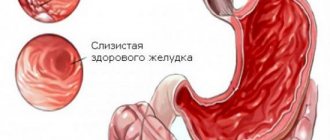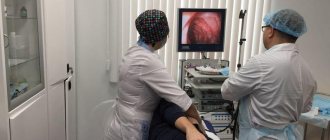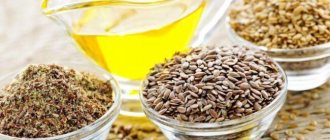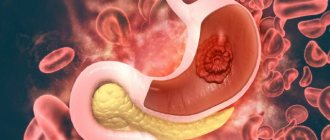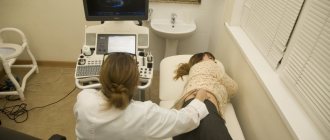Combination of heaviness in the stomach with other symptoms of diseases of the gastrointestinal system
With functional dyspepsia, during a thorough examination, it is not possible to detect organic damage to organs and tissues of the body.
The main cause of this disorder is considered to be impaired contractility of the duodenum. Functional dyspepsia, in addition to epigastric discomfort, is characterized by pain, nausea, vomiting, belching of air, and heartburn. The same symptoms are observed in various forms of gastritis, gastroduodenitis, acute and chronic ulcers. Most often, a prolonged feeling of fullness in the upper abdomen occurs with atrophic gastritis. It is characterized by a decrease in the secretion of hydrochloric acid, and therefore food lingers in the stomach for a long time. Atrophic gastritis is accompanied by decreased appetite, drooling, and belching with an unpleasant taste in the mouth.
Among the manifestations of acute ulcers, the dominant place is occupied by pain. However, as ulcerative defects heal, scars form that narrow the pylorus (the junction of the stomach and duodenum). This condition is called pyloric stenosis. In the early stages, pyloric stenosis is characterized by heaviness in the stomach after eating, nausea, and belching. When the disease decompensates, the feeling of fullness can be constantly disturbing, frequent vomiting of eaten food appears, and exhaustion develops.
Discomfort in the epigastric region with chronic pancreatitis is associated with a decrease in the ability of the pancreas to secrete digestive enzymes. These symptoms are combined with unstable, foul-smelling, greasy stools, and weight loss even with regular and proper nutrition.
With pathology of the biliary tract or liver, heaviness and pain spread to the right hypochondrium. Often there is a bitter taste in the mouth, yellowness of the skin and sclera.
In case of intestinal diseases, in addition to severity and pain, changes in the frequency and consistency of stool (constipation, diarrhea), flatulence, and bloating are observed.
In case of cancer, discomfort in the upper abdomen is combined with the following manifestations:
- change in taste preferences, aversion to meat;
- rapid loss of body weight;
- signs of anemia (weakness, dizziness, pallor of the skin, mucous membranes, palpitations);
- hypovitaminosis (brittle nails, hair, fatigue);
- pain is intermittent and unnecessary.
Important signs of food poisoning are vomiting, fever, headaches, general weakness, and frequent, loose stools.
Symptomatic treatment of heaviness in the stomach
A proper diet will help get rid of the feeling of heaviness in the stomach.
Self-medication is not recommended. To begin with, it is better to adjust your diet and diversify it, be sure to find time for hot lunches, and eat vegetables and fruits daily that promote digestion.
You should also try to avoid eating dry food, snacking on pies and sandwiches, as well as nighttime overeating. It is advisable to eat food 3-4 hours before bedtime.
Diagnostics
A gastroenterologist finds out the causes of heaviness in the stomach after eating and treats the pathology. During the initial consultation, the specialist collects a detailed medical history:
- analyzes complaints, their frequency and duration;
- asks about hereditary and concomitant diseases;
- clarifies whether treatment was carried out previously and by what means.
Then the doctor conducts a physical examination: examines the skin, sclera, mucous membranes, palpates the abdomen, and checks for pathognomonic symptoms using special methods. Based on the information received, he makes a preliminary diagnosis, then prescribes a series of instrumental and laboratory tests.
- Fiber gastroduodenoscopy (FGDS) is an examination of the walls of the esophagus, stomach and duodenal bulb using an endoscope. During the procedure, the doctor plucks tissue from pathologically changed areas, that is, performs a biopsy. Based on the results of histological examination, the form, stage, and activity of the pathological process are judged, and precancerous and cancerous conditions are verified. They also determine the presence of Helicobacter pylori, a bacterium that is the direct cause of ulcers.
- Colonoscopy is an endoscopic method of visual examination of the large intestine, during which a biopsy is performed.
- X-ray examination using barium contrast agent. Using a series of photographs of the upper part of the digestive system, organic defects in the walls (for example, ulcers) are determined and the motor function of the stomach is judged. Most often used to determine the stage of pyloric stenosis.
- Ultrasound examination (ultrasound) of the abdominal cavity. This technique is used as a screening examination method, as it allows one to identify developmental anomalies, the location of organs, inflammatory and degenerative processes, tumors, stones in the gall bladder and pancreas.
- Computed and magnetic resonance tomography. These techniques are usually used to clarify the location, size, type, and spread to neighboring organs of space-occupying formations.
- General and biochemical blood test. Allows you to identify anemia, inflammation, liver and kidney dysfunction.
- Fecal analysis for occult blood, dysbacteriosis, helminth eggs, coprogram (examination under a microscope).
Causes of heartburn and nausea at the same time
Heartburn and nausea after eating can occur at the same time, and in some cases, nausea can begin after the burning sensation in the chest. Common causes of symptoms:
- binge eating;
- abuse of fatty, fried, difficult-to-digest foods;
- smoking;
- alcohol consumption;
- taking medications that relax the sphincter between the stomach and esophagus;
- consumption of products containing caffeine and cocoa beans;
- pregnancy, especially the last trimester;
- overweight;
- tight clothing that puts pressure on the stomach 5.
Treatment of heaviness in the stomach associated with poor nutrition
If the feeling of fullness in the upper abdomen occurs rarely and is definitely associated with errors in nutrition, then experts recommend normalizing your eating habits:
- eat 4-6 times a day in small portions of 100-250 g;
- exclude high-calorie foods, fried, smoked and fatty foods from the diet;
- reduce the consumption of gas-forming foods (legumes, bread) and alcohol;
- after eating, do not engage in physical exercise and do not take a horizontal position; a light walk is considered optimal;
- if heaviness in the stomach occurs once, then you are allowed to take an over-the-counter enzyme preparation;
- include in the menu foods rich in fiber, vitamins, and microelements;
- keep a food diary, which records the time of food intake, foods, their quantity, and how you feel after eating.
Why can sweets cause heartburn?
An unpleasant burning sensation behind the sternum has a direct connection with nutrition. An excess of simple carbohydrates in the diet can increase acid production and also provoke increased gas formation1. Both parameters increase the risk of food reflux from the stomach into the esophagus, which can cause heartburn.
Carbohydrate foods that may cause burning include:
- chocolate;
- cakes, butter cookies;
- sweet carbonated drinks;
- sweet coffee and tea;
- any baked goods;
- fruit juices with sugar;
- sweets2,3.
Not every person gets heartburn from sweets. The risk of developing a symptom increases if there are additional factors:
- binge eating;
- eating fried, fatty foods;
- smoking;
- alcohol consumption;
- overweight;
- pregnancy;
- wearing tight belts;
- excessive physical activity after eating, especially bending;
- horizontal position after eating3.
The occurrence of heartburn after eating sweets more than once a week for several months may indicate the development of gastroesophageal reflux disease2. Main symptoms: heartburn and sour belching3. The disease occurs due to persistent weakening of the muscular sphincter between the stomach and esophagus2.
Treatment of heaviness in the stomach associated with diseases of the gastrointestinal tract
If discomfort in the epigastric region bothers you periodically and is accompanied by other symptoms, then you should definitely seek qualified help from a gastroenterologist.
Even before an accurate diagnosis is established, the doctor recommends lifestyle and diet adjustments and prescribes certain medications. After determining the cause of heaviness in the upper abdomen, the specialist determines a therapeutic diet, and also recommends a specific combination of drugs, dosage regimen and duration of therapy. To get rid of stomach discomfort and accompanying manifestations of diseases, groups of medications are used.
- Enzyme preparations. Contain enzymes (amylase, lipase, protease) that are involved in digestion. Recommended for pancreatic dysfunction.
- Prokinetics. Helps normalize the motility of the gastrointestinal system.
- Antacids. Topical compounds that neutralize hydrochloric acid. Mainly used for insufficiency of the cardia and pylorus.
- Agents that reduce the production of hydrochloric acid. These include proton pump inhibitors, H2-blockers and M-anticholinergics. Prescribed for hyperacid gastritis, gastric and duodenal ulcers.
- Drugs that increase gastric secretion, they contain pepsin and acids necessary for atrophic gastritis.
- Gastrocytoprotectors. Medicines that protect against the effects of adverse factors and promote the healing of damaged areas of the walls of the digestive organs. These include analogues of prostaglandin E and bismuth salts.
- Antibiotics. They are part of complex therapy for the destruction of Helicobacter pylori.
- Drugs that affect the secretion and excretion of bile. Used for diseases of the liver and biliary tract.
- Laxatives. Recommended for constipation of various etiologies.
Diagnosis and treatment of functional (non-ulcer) dyspepsia
Cytokines (IL-1b, IL-6, IL-8) and tumor necrosis factor-alpha (TNF-alpha) are involved in the inhibitory effect of H. pylori on gastric motility. Taking this into account, anti-Helicobacter therapy can lead to normalization of gastric motility.
However, complete elimination of dyspeptic complaints is observed only in 20–25% of patients with FD. H. pylori eradication was found to have a beneficial effect on symptoms in patients with FD in only 8 of 16 studies. According to the conclusion of the US National Institutes of Health (1994), treatment of Helicobacter pylori infection in patients with FD is not required.
However, a number of studies have shown that the frequency of Helicobacter pylori infection among patients with non-ulcer dyspepsia is higher than in healthy individuals. In addition, H. pylori infection can cause dyspeptic symptoms.
Other authors have questioned the value of H. pylori eradication in the treatment of Helicobacter pylori-associated FD in order to eliminate symptoms. It was not possible to identify significant differences in the reduction in the frequency of dyspepsia symptoms, regardless of whether patients received anti-Helicobacter therapy or not. There is evidence that a year after treatment, symptoms of FD in patients with successful eradication of H. pylori are observed more often than in patients who were not previously treated with anti-Helicobacter therapy.
Among similar works, the study by J. Gillvary et al. stands out. (1997), because the classic “triple therapy” with colloidal bismuth subcitrate was used as an eradication scheme, and a good symptomatic response was obtained in patients. Since in some patients with FD, eradication of H. pylori leads to long-term improvement in well-being, the Maastricht Consensus II (2000) named FD as an indication for anti-Helicobacter therapy.
New facts served as the reason for holding the Third Council of Leading Scientists working on the problem of Helicobacter pylori infection in March 2005. As a result, the Third Maastricht Consensus was developed, which defines approaches to the diagnosis and eradication of H. pylori infection.
According to the new consensus, patients with untested FD are subject to mandatory testing for H. pylori infection and eradication therapy.
According to the 2nd and 3rd Maastricht consensuses, the “gold standard” for diagnosing Helicobacter pylori infection and confirming the success of eradication remains the breath test. But for bleeding ulcers, atrophic gastritis, MALT lymphomas, and after taking proton pump inhibitors (PPIs), this method is not recommended, since the likelihood of false results increases significantly. In these cases, the method of choice is to determine antibodies in the blood. When conducting epidemiological studies, preference is given to non-invasive methods for detecting H. pylori antigens in saliva and urine.
The new consensus provides for first-line treatment regimens and reserve eradication regimens, as well as “salvage therapy”, which is used in cases of failure of therapy with first-line drugs and reserve agents. Two well-proven triple regimens are offered as 1st-line therapy: PPI + clarithromycin + amoxicillin or metronidazole. In accordance with the Maastricht Consensus III, three-component anti-Helicobacter therapy lasting 14 days increases eradication efficiency by 12%. Moreover, it is undesirable to prescribe clarithromycin in the population if there is data on the resistance of H. pylori to this antibiotic over 30%. The same applies to metronidazole and amoxicillin, although resistance to the latter in H. pylori is much less common.
In the case of simultaneous resistance of H. pylori to two 1st-line drugs, it is recommended to immediately begin eradication with a reserve regimen, i.e., use the reserve treatment regimen as the first line.
Psychotropic drugs. Includes antidepressants, serotonin receptor and serotonin reuptake blockers, anxiolytics. Currently, there are no results from controlled studies on the use of these drugs in FD. It should be expected that the effect of such drugs is close to their beneficial effect on patients suffering from non-cardiac thoracalgia or irritable bowel syndrome.
Empirical therapy. If there are no signs of serious organic diseases or they were not detected during a standard diagnostic examination, the prescription of so-called empirical therapy is justified.
In young patients without signs of organic gastric diseases, a serological test for IgG antibodies to H. pylori or a urease breath test is used to detect Helicobacter pylori infection. Patients with positive test results should be given eradication therapy. If the dyspeptic symptoms disappear, no further examination is required.
In patients who do not have Helicobacter pylori infection or have it but have not responded to treatment with anti-Helicobacter pylori drugs, treatment with H2 blockers or proton pump inhibitors and prokinetics should be started. If there is no effect, endoscopy and other studies are indicated to select further treatment tactics.
Antacids. Studies on reducing gastric acidity in the treatment of FD have revealed the low effectiveness of antacids. Thus, 14 of 24 studies showed that these drugs in high doses caused an improvement in well-being in 35-80% of patients compared to 30-60% of people receiving placebo.
Antacids are well known to both patients and doctors, their use has been proven to be safe, so this group of drugs is used in FD.
The most commonly used (both on the recommendations of doctors and taken by patients on their own) are antacids such as Almagel Neo, Phosphalugel, Rutacid, Gelusil Lac, the main property of which is to neutralize the acid secreted by the parietal cells of the mucous membrane. This allows you to quickly reduce the intensity of pain in the epigastric region and heartburn, and in many patients - other dyspeptic disorders.
The drug "Almagel Neo" allows you not only to neutralize the acidic contents of the stomach, but also to eliminate symptoms of discomfort, prevent the occurrence of flatulence, and improve bowel movements. The effectiveness of Almagel Neo is due to the optimal content of aluminum hydroxide and magnesium hydroxide in its composition and the presence of the defoamer simethicone.
Acid suppressive drugs. This is a group of drugs that are often used to treat FD. Some authors believe that the positive results from histamine H2 receptor antagonists in a number of clinical trials were obtained due to the group of patients with GERD who were included in these trials due to imperfect selection criteria.
However, the meta-analysis by G. Dobrilla et al. (1989) showed that when using H2-blockers, the therapeutic effect was 20% greater than the placebo effect.
There is an opinion that a high dose of histamine H2 receptor antagonists is effective for FD, but serious research is needed to confirm this.
PPIs have so far been little used in FD. A recently completed study with high statistical significance showed a good effect of omeprazole in FD, and the best result was obtained in the group of patients with the ulcer-like variant compared to the dyskinetic one. In the OCAY study, omeprazole monotherapy was effective in relieving symptoms of dyspepsia, as was eradication therapy for H. pylori infection.
Discussions continue regarding the selection of the optimal PPI. The Russian Gastroenterological Association recommends the use of rabeprazole. A sustainable effect from its use is noted from the 1st day. In addition, there is no need for a 2-3 day interval between the administration of rabeprazole and the antibacterial components of eradication therapy; they can be used in combination from the first days. Amoxicillin and clarithromycin exhibit an antibacterial effect against H. pylori only at a pH of 5.0 and above, therefore, the administration of other PPIs with a longer period of onset of effect simultaneously with these antibiotics leads to a decrease in the % eradication of H. pylori.
Most experts believe that there are no significant differences in the effectiveness of eradication therapy depending on which PPI is used. The summary of Maastricht III does not mention individual names of PPIs at all, which apparently reflects the absence of any disagreement among experts on this component of FD treatment.
All major PPIs are present on the domestic pharmaceutical market: omeprazole, lansoprazole, pantoprazole, rabeprazole and esomeprazole. Omeprazole is used more often than others in Russian practice, which is quite justified given the number of clinical studies on this drug. The domestic generic, which has undergone bioequivalence studies to the original drug, is Gastrozol.
We have experience with a course of monotherapy with the drug "Omez" at a dose of 20 mg 2 times a day for 4 weeks in 12 patients diagnosed with FD syndrome, 8 of whom had ulcerative type FD, 2 had dyskinetic type FD, 2 had nonspecific FD. . The age of the patients ranged from 22 to 35 years, among them there were 5 men and 7 women. In the control group (n = 10), comparable in gender and age to the main group, ranitidine was used at a dose of 150 mg 2 times a day.
During the treatment, it was found that in the group using Omez, the severity of clinical symptoms decreased significantly more quickly, the level of anxiety on the Taylor scale, depression on the Zung scale decreased, the Kerdo autonomic index normalized, the severity of pain on the visual analogue scale (VAS) decreased, and the quality of life increased (QoL) compared with the comparison group where ranitidine monotherapy was used.
Why do heartburn and nausea need to be treated?
Even if the cause of heartburn and nausea is not diseases of the gastrointestinal tract (GIT), the problem should not be ignored. Frequently recurring symptoms gradually lead to the formation of the following problems:
- Esophagitis is inflammation of the walls of the esophagus. Due to constant burns, wounds are formed into which bacteria enter and an inflammatory process develops3.
- GERD – gastroesophageal reflux disease. Develops due to persistent relaxation of the esophageal sphincter6. Most often it accompanies diseases of the digestive system, that is, it occurs secondarily. But there are cases of the development of primary GERD, which is a chronic disease that requires an integrated approach.
- Narrowing of the esophagus. Ulcers on the walls of the organ become scarred, causing the lumen of the esophagus to narrow. It is difficult for a person to pass food, which significantly impairs the quality of life.
- Barrett's esophagus. Long-term damage to an organ by hydrochloric acid can provoke degeneration of the epithelial cells lining the walls. The disease is considered precancerous and can lead to the development of cancer1.
Prevention
Proper diet and nutrition are the basis for successfully preventing heartburn and nausea. Additional recommendations:
- rejection of bad habits;
- correct work and rest schedule;
- weight loss;
- refusal of uncontrolled use of NSAIDs;
- wearing loose clothing without tight belts or corsets.
Timely treatment of diseases of the digestive system accompanied by heartburn, including recommendations for the use of Omez 10 mg, helps relieve heartburn.
THERE ARE CONTRAINDICATIONS, YOU MUST READ THE INSTRUCTIONS FOR MEDICAL USE OR CONSULT A DOCTOR.
